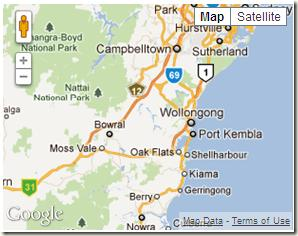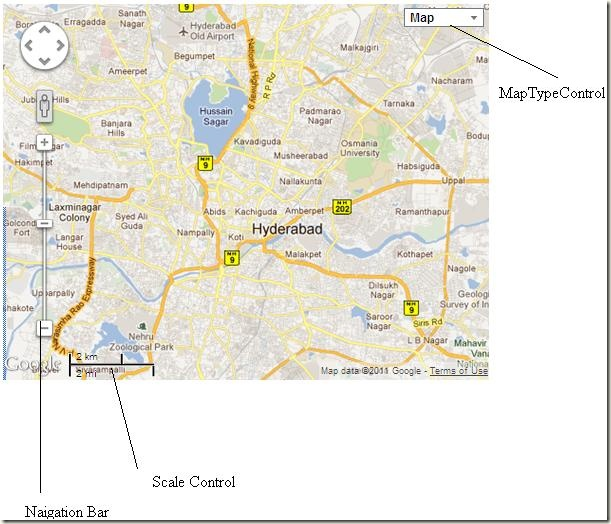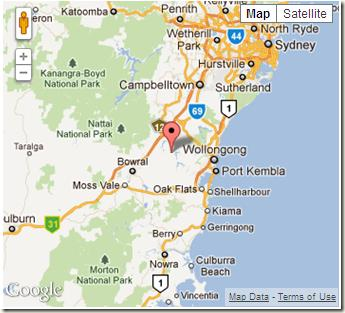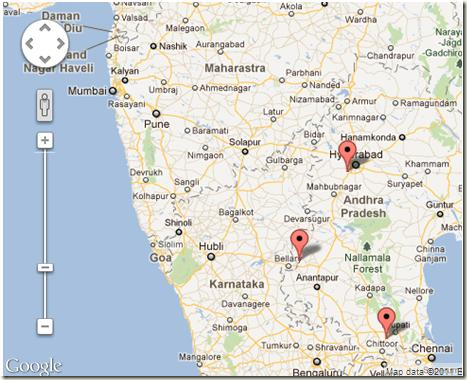[转载]ASP.NET中使用V3版本的Google Maps API【译】 – sxwgf – 博客园.
写在最前面
早 就听说过Google Maps API了,但一直没用过,今天在CodeProject上看到了这篇关于Google Maps API(V3版本)使用的文章,觉得很容易上手,就将他翻译下来了,相信对初学者会有大的帮助。译文允许转载,但请在页面明显处标明以下信息,且保留完整 原文链接地址和译文链接地址,谢谢合作!
英文原文:Google Maps API V3 for ASP.NET
译文出处:青藤园
译文作者:王国峰
译文链接:ASP.NET中使用Google Maps API V3【译】
简介
Google Maps为我们提供了一种非常灵活的方式来使用它的地图服务。我们可以在Web应用程序中通过调用Google Maps API来为我们的用户提供方位信息、地理位置信息以及其他类型的东西。尽管已经有很多文章介绍了Google Maps API的使用方法,但这次我要介绍的是最新V3版本的Google Maps API。在这篇文章中,我们将会看到一些使用Google Maps的常见技术。为了能更好的理解下面的示例代码,你需要了解JavaScript和C#的基本知识。
你的第一个Google Maps
在Google Maps API的早期版本中,我们需要将自己的web应用程序注册至Google,从而获取一个API Key。然而随着新版本的发布,Google Maps的注册机制已经被淘汰了,但是最近Google又提出了一些使用地图的限制,你可以通过下面的链接获取Google Maps API的使用方法和一些使用条款:http://code.google.com/apis/maps/documentation/javascript/usage.html#usage_limits 。现在我们就开始在自己的网站下创建一个Google Maps地图示例,下面的一行代码是用来连接Google Maps API服务的:
<script type="text/javascript" src="http://maps.googleapis.com/maps/api/js?sensor=false"> </script>
然后你可以用下面的代码来创建一个简单的地图:
function InitializeMap() { var latlng = new google.maps.LatLng(-34.397, 150.644); var myOptions = { zoom: 8, center: latlng, mapTypeId: google.maps.MapTypeId.ROADMAP }; var map = new google.maps.Map(document.getElementById("map"), myOptions); } window.onload = InitializeMap;
Google Maps 设置选项
在上面的例子中,我们使用了一个Map类,并设置了一个HTML ID作为参数。现在我们来更深入一点,一起来看看下面的地图选项:
function initialize() { var latlng = new google.maps.LatLng(-34.397, 150.644); var options = { zoom: 3, center: new google.maps.LatLng(37.09, -95.71), mapTypeId: google.maps.MapTypeId.ROADMAP, mapTypeControl: true, mapTypeControlOptions: { style: google.maps.MapTypeControlStyle.DROPDOWN_MENU, poistion: google.maps.ControlPosition.TOP_RIGHT, mapTypeIds: [google.maps.MapTypeId.ROADMAP, google.maps.MapTypeId.TERRAIN, google.maps.MapTypeId.HYBRID, google.maps.MapTypeId.SATELLITE] }, navigationControl: true, navigationControlOptions: { style: google.maps.NavigationControlStyle.ZOOM_PAN }, scaleControl: true, disableDoubleClickZoom: true, draggable: false, streetViewControl: true, draggableCursor: 'move' }; var map = new google.maps.Map(document.getElementById("map"), options); } window.onload = initialize;
上面的例子中,我们应用了地图的所有属性,你可以根据需要来选择使用它们。
Map类的属性说明如下表所示
| 属性 | 类 | ||||||||||||||
MapTypeControl:true/false |
mapTypeControlOptions
|
||||||||||||||
navigationControl:true/false |
navigationControlOptions
|
||||||||||||||
scaleControl:true/false |
scaleControlOptions: 和navigationControl有一样的属性 (position, style) 方法也一样. |
||||||||||||||
disableDoubleClickZoom: true/false |
|||||||||||||||
scrollwheel: true/false |
|||||||||||||||
draggable: true/false |
|||||||||||||||
streetViewControl: true/false |
Map Maker(地图标记)
Maker类提供了这样一个选项,为用户指定的位置显示一个标记,在我们的应用中地图标记是十分常用的,下面的代码将告诉大家如何创建一个简单的地图标记:
var marker = new google.maps.Marker ( { position: new google.maps.LatLng(-34.397, 150.644), map: map, title: 'Click me' } );
Info Window(信息窗口)
我们已经在地图上某个位置加了标记,也为标记添加onclick了事件,点击可以弹出一个窗口来显示该地点的详细信息。我们可以按照下面的代码来创建信息窗口:
var infowindow = new google.maps.InfoWindow({ content: 'Location info: Country Name: LatLng:' }); google.maps.event.addListener(marker, 'click', function () { // 打开窗口 infowindow.open(map, marker); });
将它们结合起来的代码如下:
var map; function initialize() { var latlng = new google.maps.LatLng(-34.397, 150.644); var myOptions = { zoom: 8, center: latlng, mapTypeId: google.maps.MapTypeId.ROADMAP }; map = new google.maps.Map(document.getElementById("map"), myOptions); var marker = new google.maps.Marker ( { position: new google.maps.LatLng(-34.397, 150.644), map: map, title: 'Click me' } ); var infowindow = new google.maps.InfoWindow({ content: 'Location info: Country Name: LatLng:' }); google.maps.event.addListener(marker, 'click', function () { // Calling the open method of the infoWindow infowindow.open(map, marker); }); } window.onload = initialize;
利用上面的代码,我们将会在页面上创建一张地图,然后定位用户所在的区域,在这个区域加上标记,并且弹出一个显示位置信息的窗口。
Multiple Makers(多标记)
有些时候,我们可以要在地图上处理多个标记,那么我们就可以用下面代码来实现:
function markicons() { InitializeMap(); var ltlng = []; ltlng.push(new google.maps.LatLng(40.756, -73.986)); ltlng.push(new google.maps.LatLng(37.775, -122.419)); ltlng.push(new google.maps.LatLng(47.620, -122.347)); ltlng.push(new google.maps.LatLng(-22.933, -43.184)); for (var i = 0; i <= ltlng.length; i++) { marker = new google.maps.Marker({ map: map, position: ltlng[i] }); (function (i, marker) { google.maps.event.addListener(marker, 'click', function () { if (!infowindow) { infowindow = new google.maps.InfoWindow(); } infowindow.setContent("Message" + i); infowindow.open(map, marker); }); })(i, marker); } }
路线说明
一个最有用的特性之一是Google Maps API可以为任何指定的位置提供详细的路线说明,实现代码如下:
Code
Layers
Google Maps API为你提供了多层的选项,其中有一个是自行车层。通过自行车层,可以为一些特别的位置显示自行车路线。下面的代码是让你在地图上添加自行车层:
Code
Geocoding
到目前为止,我们已经学习创建Google地图的基本思想,同时也学习了如何显示位置相关的信息。下面我们来看看用户是如何来计算位置的,Geocoding可以计算出指定区域的经度和纬度,下面的代码就告诉你如何利用API计算某个位置的经度和纬度的:
geocoder.geocode({ 'address': address }, function (results, status) { if (status == google.maps.GeocoderStatus.OK) { map.setCenter(results[0].geometry.location); var marker = new google.maps.Marker({ map: map, position: results[0].geometry.location }); } else { alert("Geocode was not successful for the following reason: " + status); } });
Geocoding C#
同样我们可以利用C#代码来计算位置:
public static Coordinate GetCoordinates(string region) { using (var client = new WebClient()) { string uri = "http://maps.google.com/maps/geo?q='" + region + "'&output=csv&key=ABQIAAAAzr2EBOXUKnm_jVnk0OJI7xSosDVG8KKPE1" + "-m51RBrvYughuyMxQ-i1QfUnH94QxWIa6N4U6MouMmBA"; string[] geocodeInfo = client.DownloadString(uri).Split(','); return new Coordinate(Convert.ToDouble(geocodeInfo[2]), Convert.ToDouble(geocodeInfo[3])); } } public struct Coordinate { private double lat; private double lng; public Coordinate(double latitude, double longitude) { lat = latitude; lng = longitude; } public double Latitude { get { return lat; } set { lat = value; } } public double Longitude { get { return lng; } set { lng = value; } } }
Reverse Geocoding
顾名思义,这个是Geocoding的反操作,我们可以根据经度和纬度来找出该位置的名称。代码如下:
var map; var geocoder; function InitializeMap() { var latlng = new google.maps.LatLng(-34.397, 150.644); var myOptions = { zoom: 8, center: latlng, mapTypeId: google.maps.MapTypeId.ROADMAP, disableDefaultUI: true }; map = new google.maps.Map(document.getElementById("map"), myOptions); } function FindLocaiton() { geocoder = new google.maps.Geocoder(); InitializeMap(); var address = document.getElementById("addressinput").value; geocoder.geocode({ 'address': address }, function (results, status) { if (status == google.maps.GeocoderStatus.OK) { map.setCenter(results[0].geometry.location); var marker = new google.maps.Marker({ map: map, position: results[0].geometry.location }); if (results[0].formatted_address) { region = results[0].formatted_address + ' '; } var infowindow = new google.maps.InfoWindow({ content: 'Location info: Country Name:' + region + ' LatLng:' + results[0].geometry.location + '' }); google.maps.event.addListener(marker, 'click', function () { // Calling the open method of the infoWindow infowindow.open(map, marker); }); } else { alert("Geocode was not successful for the following reason: " + status); } }); }
Reverse Geocoding in C#
同样用C#也可以实现Reverse Geocoding操作:
static string baseUri = "http://maps.googleapis.com/maps/api/geocode/xml?latlng={0},{1}&sensor=false"; string location = string.Empty; public static void RetrieveFormatedAddress(string lat, string lng) { string requestUri = string.Format(baseUri, lat, lng); using (WebClient wc = new WebClient()) { string result = wc.DownloadString(requestUri); var xmlElm = XElement.Parse(result); var status = (from elm in xmlElm.Descendants() where elm.Name == "status" select elm).FirstOrDefault(); if (status.Value.ToLower() == "ok") { var res = (from elm in xmlElm.Descendants() where elm.Name == "formatted_address" select elm).FirstOrDefault(); requestUri = res.Value; } } }
总结
在这篇文章,我尝试将V3版本的Google Maps API中的最基本和最常用的功能解说清楚。希望这篇文章能帮你顺利完成任务。然后,API中还有很多我没有讨论到的,我将尝试在今后的文章中来讨论。当然希望能得到大家的点评和反馈。
 Mikel
Mikel







